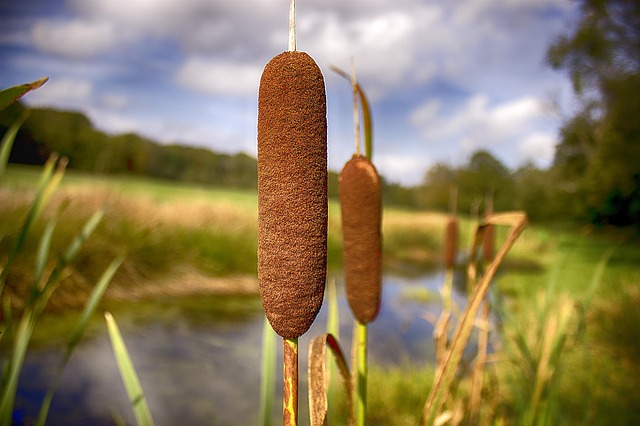My earliest memory of cattails (Typha genus) is from watching that old Disney cartoon version of “The Legend of Sleepy Hollow.” The cattails were blowing in the wind on an eerie night and thumping against a log, conjuring the sounds of horse hooves galloping up to catch poor Ichabod. This made quite an impression on my younger self, and to this day I associate cattails with spooky things. But have no fear, dear reader. I’ll take the creepy out of cattails, and show you how to use this prolific plant for food and fun.
Location & Identification
Cattails (called bulrushes in some places) are water-loving plants. You can find them in marshes, swamps, or clogging up ponds across most of the planet. Chances are, if you have slow-moving water, you’re not too far from some variety of native or invasive cattail.
Young cattails have a couple of dangerous look-alikes, but mature plants are unmistakable. They have long, sword-like or strap-like leaves and a long, non-branching, central stalk that ends in what looks like a corndog on a stick. For part of the year, they have 2 corndogs. The lower one is the female part of the plant. The upper, smaller section is male. Nothing else looks like a mature cattail.
Cattails are wind pollination and spread via the profuse number of fluffy-tipped seeds that are carried near and far by the wind. They also spread by underground rhizomes that can reach out over a foot from the parent plant. Young plants are safest to identify when they are at the base of older plants, but can also be distinguished by base, which is oval, rather than flat. Cattails also have a mild taste and smell. If you harvest a plant with a strong smell, you don’t have a cattail.
Culinary Cattails
Cattails are sometimes called the supermarket of the swamp. They have several edible parts, with something to offer year-round. In spring, you can eat the tender, young stalks. They are often prepared like asparagus. The core of growing stalks remain edible until they become too tough, around the time the cattail goes into bloom (the corndog stage). Even after this, the core of the lowest couple of inches of each stalk will likely retain a tender bite or two and can be eaten raw. They remind me somewhat of cucumbers.
The upper, male part of the cattail can be blanched or served in a stir-fry, when young. If you leave it until early summer, you can harvest its protein-rich pollen and add it to bread, soup, or smoothies.
Rhizomes (root-like, underground stems) are available year-round, and are most nutritious in the fall, when the plant uses them to store food for the following spring. How do you prepare them? Well, there are some different views on that. Many sources will tell you to peel and then crush them in a water-filled bowl and let the starch settle to the bottom. This works, but it’s more trouble than it’s worth, in my opinion.
My favorite method is to peel and boil them. You can then chew up the starch and spit out the fibers. An even easier method is to toss them onto the grill until their outer core is blackened on both sides. You can do this in the coals of a campfire, as well. The taste is not exactly like a potato, but it’s close enough to give you an idea of what to expect.
Cattail starch could also be mixed in with stews or dried and mixed into flour for bread. Whatever you choose, be sure to cook the starch before eating it.
Be sure to harvest plants from clean water sources. Cattail is prone to absorbing heavy metals, pharmaceuticals, and other pollutants.1)Xu, Qian, Sylvie Renault, Doug Goltz, and Qiuyan Yuan. “Phytoremediation of Waste Dumping Site Soil and Landfill Leachate by Using Cattail (Typha Latifolia).” Environmental Technology, 2018, 1-6. doi:10.1080/09593330.2018.1521474.2)Luca, G.a. Di, M.m. Mufarrege, H.r. Hadad, and M.a. Maine. “Nitrogen and Phosphorus Removal and Typha Domingensis Tolerance in a Floating Treatment Wetland.” Science of The Total Environment650 (2019): 233-40. doi:10.1016/j.scitotenv.2018.09.042.3)Jiang, Bo, Yi Xing, Baogang Zhang, Ruquan Cai, Dayi Zhang, and Guangdong Sun. “Effective Phytoremediation of Low-level Heavy Metals by Native Macrophytes in a Vanadium Mining Area, China.” Environmental Science and Pollution Research25, no. 31 (2018): 31272-1282. doi:10.1007/s11356-018-3069-9.4)Liang, Yan Ling, Tamara E.c. Kraus, Lucas C.r. Silva, Philip A.m. Bachand, Sandra M. Bachand, Timothy A. Doane, and William R. Horwath. “Effects of Ferric Sulfate and Polyaluminum Chloride Coagulation Enhanced Treatment Wetlands on Typha Growth, Soil and Water Chemistry.” Science of The Total Environment648 (2019): 116-24. doi:10.1016/j.scitotenv.2018.07.341.5)Cui, Hao, and Peter Schröder. “Uptake, Translocation and Possible Biodegradation of the Antidiabetic Agent Metformin by Hydroponically Grown Typha Latifolia.” Journal of Hazardous Materials308 (2016): 355-61. doi:10.1016/j.jhazmat.2016.01.054.6)Li, Jing, Haixin Yu, and Yaning Luan. “Meta-Analysis of the Copper, Zinc, and Cadmium Absorption Capacities of Aquatic Plants in Heavy Metal-Polluted Water.” International Journal of Environmental Research and Public Health12, no. 12 (2015): 14958-4973. doi:10.3390/ijerph121214959.7)Zhang, Dongqing, Jinxue Luo, Zarraz May Ping Lee, Richard M. Gersberg, Yu Liu, Soon Keat Tan, and Wun Jern Ng. “Ibuprofen Removal in Horizontal Subsurface Flow Constructed Wetlands: Treatment Performance and Fungal Community Dynamics.” Environmental Technology37, no. 12 (2016): 1467-479. doi:10.1080/09593330.2015.1119201. It’s so good at this that companies and environmental agencies will intentionally plant them in polluted water. So when you find a big stand of cattails, be sure to check upstream.
Nutritionally, cattails are probably most useful as calorie sources. They produce quite a lot of starch, which could help to keep you alive in a survival situation, or just feed a hungry family at mealtime. Cattails are a great way to stretch your meal budget. Aside from calories, cattails are also good sources of vitamins A, B, and C, plus potassium and phosphorus.
Bonus Tips and Tricks
Not only are cattails an excellent food source, but also they’re excellent utility plants. Whether for survival or the joy of crafts, you’ll be surprised at how much you can do with cattails.
First of all, for a plant that grows in water, cattail has a lot of fire-related uses. The seed fluff makes excellent tinder for starting a fire. It also makes a good insulation, if you have enough. The dried stalk can also be used as a bow drill for starting fires.
The mature seed heads (the corndog on a stick) can also be turned into a long-lasting natural torch. To do this, either soak the end in oil, or pour oil over it. The way the cattail is constructed, it acts as a natural wick, delivering fuel to the fire without being burned itself.
Finally, the leaves can be used for all manner of weaving, crafting, and shelter-building projects. You can use cattails to make sleeping mats, cordage, baskets, chairs, and just about anything else you can imagine. The trick to working with cattails is to cut them and let them dry first. Then you can re-wet them and work them into whatever forms you need.
What Do You Think?
Do you have any fun cattail stories to share? Do you know of a better way to prepare them than I showed here? Let us know in the comments.
____________________
Psst! Our Lawyer Wants You to Read This Big, Bad Medical Disclaimer –> The contents of this article, made available via The Grow Network (TGN), are for informational purposes only and do not constitute medical advice; the content is not intended to be a substitute for professional medical advice, diagnosis, or treatment. Always seek the advice of a qualified health care provider with any questions you may have regarding a medical condition. If you think you may be suffering from any medical condition, you should seek immediate medical attention. You should never delay seeking medical advice, disregard medical advice, or discontinue medical treatment because of information provided by TGN. Reliance on any information provided by this article is solely at your own risk. And, of course, never eat a wild plant without first checking with a local expert.

Scott Sexton is a TGN Trailblazer, a highly experimental gardener, an unrelenting weed-eater, and a largely non-profit herbalist (much to his wife’s chagrin). When Scott is not teaching foraging classes, testing out theories in the garden, or grazing in the forest, he can be found at his Facebook page, “A Forager’s Guide to the Zombie Apocalypse.”
References
| ↑1 | Xu, Qian, Sylvie Renault, Doug Goltz, and Qiuyan Yuan. “Phytoremediation of Waste Dumping Site Soil and Landfill Leachate by Using Cattail (Typha Latifolia).” Environmental Technology, 2018, 1-6. doi:10.1080/09593330.2018.1521474. |
|---|---|
| ↑2 | Luca, G.a. Di, M.m. Mufarrege, H.r. Hadad, and M.a. Maine. “Nitrogen and Phosphorus Removal and Typha Domingensis Tolerance in a Floating Treatment Wetland.” Science of The Total Environment650 (2019): 233-40. doi:10.1016/j.scitotenv.2018.09.042. |
| ↑3 | Jiang, Bo, Yi Xing, Baogang Zhang, Ruquan Cai, Dayi Zhang, and Guangdong Sun. “Effective Phytoremediation of Low-level Heavy Metals by Native Macrophytes in a Vanadium Mining Area, China.” Environmental Science and Pollution Research25, no. 31 (2018): 31272-1282. doi:10.1007/s11356-018-3069-9. |
| ↑4 | Liang, Yan Ling, Tamara E.c. Kraus, Lucas C.r. Silva, Philip A.m. Bachand, Sandra M. Bachand, Timothy A. Doane, and William R. Horwath. “Effects of Ferric Sulfate and Polyaluminum Chloride Coagulation Enhanced Treatment Wetlands on Typha Growth, Soil and Water Chemistry.” Science of The Total Environment648 (2019): 116-24. doi:10.1016/j.scitotenv.2018.07.341. |
| ↑5 | Cui, Hao, and Peter Schröder. “Uptake, Translocation and Possible Biodegradation of the Antidiabetic Agent Metformin by Hydroponically Grown Typha Latifolia.” Journal of Hazardous Materials308 (2016): 355-61. doi:10.1016/j.jhazmat.2016.01.054. |
| ↑6 | Li, Jing, Haixin Yu, and Yaning Luan. “Meta-Analysis of the Copper, Zinc, and Cadmium Absorption Capacities of Aquatic Plants in Heavy Metal-Polluted Water.” International Journal of Environmental Research and Public Health12, no. 12 (2015): 14958-4973. doi:10.3390/ijerph121214959. |
| ↑7 | Zhang, Dongqing, Jinxue Luo, Zarraz May Ping Lee, Richard M. Gersberg, Yu Liu, Soon Keat Tan, and Wun Jern Ng. “Ibuprofen Removal in Horizontal Subsurface Flow Constructed Wetlands: Treatment Performance and Fungal Community Dynamics.” Environmental Technology37, no. 12 (2016): 1467-479. doi:10.1080/09593330.2015.1119201. |
















COMMENTS(1)
My husband has told me for years that cattails are a wonderful forage food, but we have never yet ventured to an area where it is available in non-toxic waters You have rekindled my interest, especially with the comments about how nutritious it is, and that it has uses as a craft material. Ironically, we live in a wetlands area, but it is a protected wetlands area where a water plant as aggressive as cattail would be planted at the cost of stiff fines. But not far south of us are counties where a little hunting might turn up a patch suitable for harvesting. Until then there appear to be websites that discuss cattail merits and precautions. We love pancakes and cucumbers, and I think cattail paper might prove to be an effective mulch!